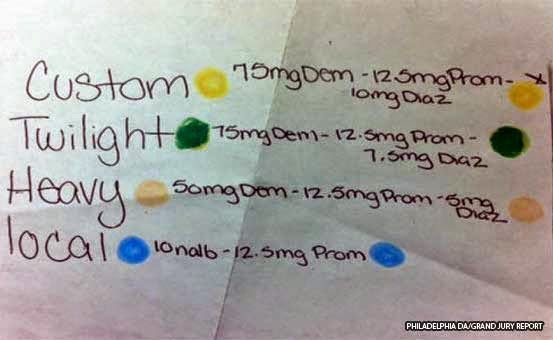At around 2:00 on the afternoon of November 30, 1874, Charles Dix went to the Madison Street Police Station to report that Dr. W. T. Aiken had performed a fatal abortion on his wife, Mary. Mary Dix had died the previous day, November 29, at around 12:30 a.m. Detective Flynn of Madison Street Station arrested Dr. W. F. Aikin, who had his office at 343 State Street. The warrant was sworn out for Aiken's arrest.
Charles said that about a week earlier, Dr. Aiken had come to the house to treat one of their two children, who was sick. Charles had been napping on the sofa and overheard a conversation between Mary and Dr. Aiken that sounded as if Mary was arranging for Aikin to perform an abortion on her. When Aiken left, Charles spoke to Mary about what he'd overheard and she admitted that he was right but promised not to follow through.Mary left the house on November 29 and was gone all afternoon and into the early evening. That night Mary was in such violent pain that Charles concluded that she'd gone through with the abortion after all.
She was doing much worse the next day, which alarmed Charles so he summoned Aiken. A servant girl walked to the Dix house with Aiken and told Charles that Aiken had said that he hoped Mrs. Dix would keep her mouth shut if anything went wrong. Charles immediately told Aikin to leave and summoned Dr. Xelonski. He cared for Mary until Friday, when her condition became so critical that he called in Dr. Fleming and Dr. Edwards to help. The three doctors were unable to save her and she died at around 1:30 on the afternoon of December 2.
On questioning, Aiken said that he had been the Dix family physician for several months, having treated both Mr. Dix and his little daughter. On November 22 Mrs. Dix had visited his office for treatment. She came again on Tuesday the 24th, when he examined her and prescribed some medicine. She told him that Dr. White, a physician in Buffalo, had operated on her. Aiken said that he advised her not to walk home but she did so anyway. On Friday the 28th he went to the Dix home and their servant told him that he wasn't to come to the house any more. Mr. Dix, he said, acted strangely and reiterated that his services were no longer wanted. The conversation Mr. Dix had over heard was Mrs. Dix, Aiken said, telling him that she'd already attempted an abortion on herself and wanted to be examined to see if the attempt had been successful. He insisted that the servant girl was of low character and that nobody should trust anything she said.
The next morning Dr. Fleming and the County Physician, Dr. Henrotin, performed an autopsy at the house. After hours of examining Mary's body and consulting with each other and Dr. Leonard they concluded that Mary's baby had been dead about three weeks before her death.
After an intensive investigation, however, a coroner's jury found no evidence that Mary had told anybody that she'd used any kind of instrument on herself. Witnesses included Julia Brown, Anna Merrit, and Dr. Van Buren. Dr. Wickersham testified about the cause of death as observed in the post-mortem examination. Their final conclusion was as followed:
An inquisition was taken for the People of the State of Illinois... on the 1st, 2nd, and 3rd days of December, A. D. 1874, before me, John Stephens, Coroner in and for said county, upon view of the body of Mary Dix, and we find that the deceased, now lying dead at 250 West Randolph street, came to her death, Nov. 30, 1874, from primary inflammation of the womb, followed by septicemia, said inflammation being the result of an effort of the deceased to produce an abortion on herself.
Aiken, age 33, was a graduate of Maryland University. He had been a doctor for fifteen years, serving as an Army surgeon during the Civil War, during which time he was wounded at Gettysburg. He came to Chicago to practice medicine after the war and lived with his wife and son in rooms adjoining his office.
When a reporter went to the Dix house to speak with Charles, a man greeted him at the door to tell him that Mr. Dix was worn out and distraught and in no condition to speak with a reporter. The man relayed to the reporter that Mr. Dix had been alarmed when his wife had returned from Aiken's office on Tuesday and had called in Dr. Fleming, Dr. Xelowski, and Dr. E.W. Edwards on Friday. The family had moved to Chicago from Buffalo. The couple had a 4-year-old son and 6-year-old daughter, and had three more children who had died.
************
On October 27, 1926, 34-year-old Sophie Peterson underwent an illegal abortion in the Chicago office of Dr. Frederick Springe. She was taken to Mercy Hospital, where she died on November 30. Springe was indicted for felony murder by a grand jury on December 15.On November 30, 1927, 22-year-old homemaker Lucille van Iderstine died in the Chicago office of Dr. Emil Gleitsman (pictured) from an abortion that had been performed on her that day. Gleitsman was indicted for felony murder in Lucille's death on January 15, 1928. Lucille's abortion was typical of illegal abortions in that it was performed by a physician. Evidently Gleitsman beat the rap on Lucille's death because he was later implicated in the abortion deaths of Jeanette Reder in 1930, Mary Colbert in 1933, and Marie O'Malley and Maggie Doe in 1942.
- "Alleged Abortion and Murder," Chicago Daily Tribune, December 1, 1874
- "The Mary Dix Murder," The Inter Ocean, December 2, 1874
- "Another Victim," The Chicago Weekly Post, December 3, 1874
- "Supposed Abortion Cases," Chicago Tribune, December 4, 1874

















